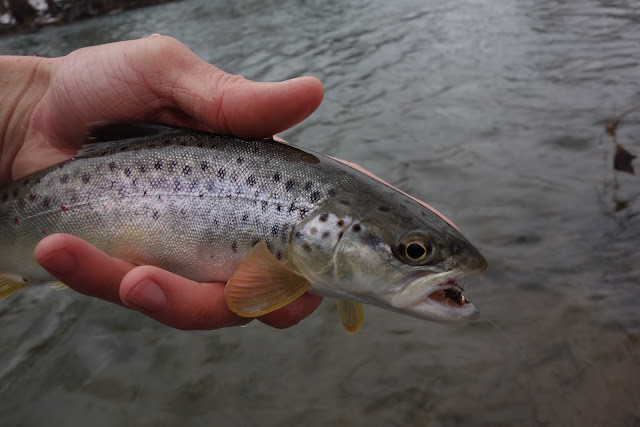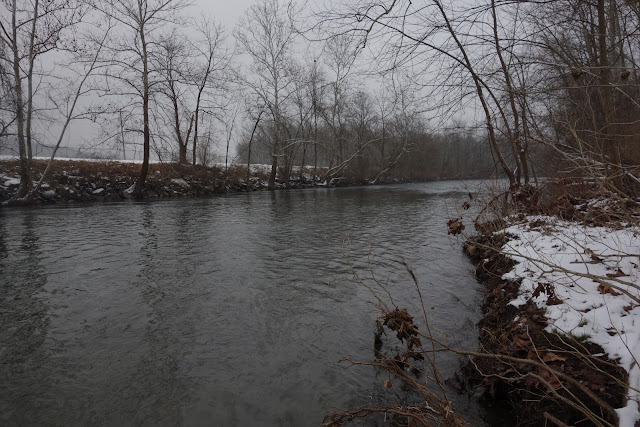It was difficult to say the least. The trout we were fishing over get pressured non-stop. They are smart and they are quick. I missed a lot of fish because they seemed to be taking exclusively the moment my fly reached the bottom 3 inches of the water column. I usually didn't see any leader movement, just a flash. Eventually I smartened up and just started to set blind as soon as the fly got into the zone. It worked, I got one small brown and lost a bigger one that was only on for a moment. Not long thereafter, it was too dark to see my sighter.
The next morning, after an appropriately slow start, we were on the water again in slightly warmer conditions. The sun never came out and there were some flurries... to me, this was ideal winter trout weather. We chose to fish an area I thought might produce some bigger fish. I marched off upstream, Mike went down. I started with a Sexy Walt's and a San Juan. When I lost that I kept the Walt's on the point and put a Hump's Cress Bug on the dropper tag. And when I lost that I kept that Walt's on the point and put a very simple pattern that is just black ice dub, olive colored wire ribbing, and a florescent orange tag with a tungsten beadhead. My leader was 9'6" long, my sighter was two lengths of yellow Suffix Hi Vis mono tied onto the leader in nail not fashion. I can adjust where on the leader they are just by sliding them. This gives me more versatility: I can slide them down the leader for fishing very shallow water, up for moderately deep water, and then use the fly line as a sighter when nymphing the deepest water. Now, I don't talk about sighters much and that's because I don't use them much. Why was I using one here? In low light winter conditions it can be much more difficult to keep track of your leader. So even if you aren't full on Euro nymphing, it is pretty smart to use some kind of versatile sighter in the winter.
That's basically what I stuck with for a nymph rig for the duration of the trip. If it ain't broke don't fix it.
The first fish I caught was a cute little wild rainbow. That was a surprise! This was my first rainbow out of Spring Creek. I was even more surprised when two casts later I hooked and lost another. Then, in the next bit of good water, I caught two more and lost a third, all rainbows.
For the next hour I caught a fair number of fish, missed some, and lost others... not one of them a confirmed brown! Some of the rainbows were clearly hatchery fish, like this one:
Others, not so much. In fact, most of the bows I was catching were fin-perfect, par marked, and brightly colored. Which isn't unexpected. Spring Creek is unstocked. Some rainbows escape from the hatcheries, others may come up from Bald Eagle Creek, but the bulk of the stream's bows are wild fish. They aren't as abundant as the browns, but for some reason they were just fired up and I was on the right pattern.
After loosing one quite decent fish, probably 16 inches and hard as nails, I headed back downstream to see how Mike had done. We split water for a little while in a good stretch of pocket water. I found a redd there, and focused my efforts on the nearby holds hoping the builders had been good sized browns and that they were somewhere close by still.
 |
| The Redd |
Clearly this fat piggy young wild bow was not one of the redd builders. But I think it has probably taken advantage of brown trout eggs ending up in the drift.
I did manage to get a few browns there just before we left Spring Creek. It is fascinating how things change work. Mike, Paolo and I fished this same area in August and it was just stacked with browns, the only rainbow I saw was a huge hatchery escapee fish caught by a bait fisherman. And even this time Mike got more browns than bows. Why? There are so many variables to take into consideration. It's things like this that keep me fascinated with fishing.
We decided to go explore a new stream, one with big fish potential. On my way back up towards the parking area I was periodically stopping and flicking casts into good looking water. I picked a few little fish up, then set into something substantial. After the set it just felt like I was lifting a clump of debris off the bottom. But then I saw something big, yellow, and orange coming towards the surface. I had just enough time to register that this was a gorgeous brown of substantial size when the fly popped out. I gasped and uttered a painful "no", staring into the bit of water into which the fish had disappeared. Yeah, that one stung.
The new stream was picture perfect streamer water. And as much as I love streamer fishing though, I can be pretty lazy about changing tactics especially in the winter. So I fished the nymphs until I lost the entire rig. I got slammed just shortly after getting to the best looking pool in the stretch. Then I caught... a friggen wild rainbow. Apparently they weren't letting me get away so easily!
About 20 feet upstream in the inside seem I hit a brown. He was a pretty good looking fish, very chrome and fin perfect.
Eventually I lost my whole tippet length to the sharp slate bottom and switched over to a streamer friendly leader system. I started with a brown and tan Complex Twist Bugger. Three casts in it got hit on the pause and the hook was set automatically on the next rod twitch. It was a chunky holdover rainbow. With action that quick I was pretty sure it was on.
150 some casts later with absolutely no takes and I was less convinced. So I lengthened my leader, tied on a much heavier sculpin pattern, and put one split shot ahead of it. A solid whack on a dead drift told me I had made a good choice, and eventually I hooked up to the best brown on the day. It wasn't big, but it fought hard and it was very colored up... I'll take it. Usually I'm about quality over quantity but some days I'll gladly take a steady pick of small-average fish. And I did need the practice, especially the nymphing. Next time I trout fish in CT though you can bet I'll be slinging meat.



















Well done guys.
ReplyDeleteA wild rainbow is a beautiful creature.
They can be quite pretty, but no local salmonids beat the brookie.
DeleteGreat post and a good read on a winter's night. Those wild rainbows, especially that fat little one, are really beautiful. Did you have the streams to yourselves this time of year?
ReplyDeleteNot entirely, other people were certainly fishing Spring Creek.
DeleteGreat trip and Rainbows. Spring Creek is a beauty and not as high as last year. Wish we could have been there.
ReplyDeleteTie, fish, write, conserve and photo on...
It was actually only a little lower than when we fished it in August. Much clearer though.
Delete